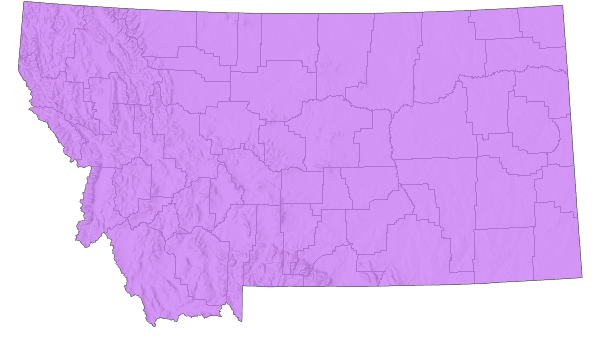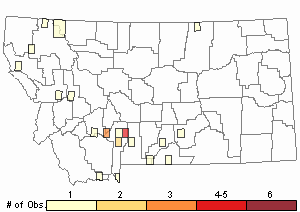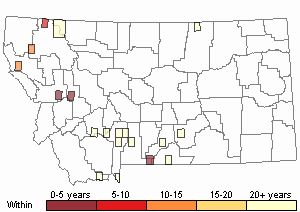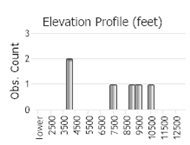View in other NatureServe Network Field Guides
NatureServe
Montana
Utah
Wyoming
Idaho
Wisconsin
British Columbia
South Carolina
Yukon
California
New York
Clear-winged Grasshopper - Camnula pellucida
General Description
The following is taken from Brooks (1958), Helfer (1971), Otte (1981), Capinera and Sechrist (1982), Vickery and Kevan (1985), McDaniel (1987), Pfadt (2002), Capinera et al. (2004), Schell et al. (2005), and Scott (2010). This is a small to medium sized, yellow to grayish-brown grasshopper with black markings and is easily identified by its clear hind wings. The side of the head has a black triangular band behind the eye. The pronotum dorsal disk (thorax) is flat, smooth, truncated and widened posteriorly. The median carina (ridge) is low and uniform throughout and lightly cut by one sulcus before the middle. The lateral lobes are deeper than long, marked anteriorly with a black rectangular stripe bordered by yellow on each side. The tegmina (forewings) extend beyond the abdomen and are marked with oval spots. When the wings are folded and viewed dorsally, yellow to amber on the forewing edges converge to form a distinct V-shape. The outer surface of the hind femur is marked with one to three oblique stripes, the inner surface is yellow with two dark markings dorsally. The hind tibia is yellowish.
Communicative behavior/Crepitation*
Neither sex crepitates, and males do not perform flight displays. Femur tipping and stridulation* are the only courtship displays a male performs. However, male territorial displays of femur tipping and shaking are often used (Otte 1970 and 1984).
*Crepitation is the sound produced by grasshoppers making a clicking or snapping noise with their wings when in flight, during courtship, territorial encounters or being disturbed.
*Stridulation is rubbing one body part against another, usually the hind femur against the forewing in the case of the Band-winged Grasshoppers. This is often used for attracting a female during courtship (Otte 1970).
Phenology
This species overwinters in the egg stage. Nymphs hatch from mid-May to mid-June. Upon hatching, nymphs begin to disperse toward nearest green vegetation. Adults occur from mid-May to end of September (Pfadt 2002, Schell et al. 2005, and Scott 2010).
Diagnostic Characteristics
The following comes from Brooks (1958), Helfer (1971), Otte (1981), Capinera and Sechrist (1982), Vickery and Kevan (1985), McDaniel (1987), Pfadt (2002), Capinera (2001), Capinera et al. (2004), Schell et al. (2005), and Scott (2010). The body length to end of forewings is 20-25 mm for males, and for females 25-31 mm. The males are noticeably smaller than females. The fourth instar nymphs are 10-14 mm, and fifth instar nymphs are 14-20 mm.
This species is the only band-winged grasshopper with a completely clear hind wing and is easily identified. However, it could be mistaken for a spur-throated species, which have clear wings and the identifying spur ventrally between the head and thorax.
Species Range
Montana Range
Range Descriptions

 Native
Native
Range Comments
This species occurs from the West Coast eastward to the northern East Coast. From the southeast corner of Alaska, across the Canadian Provinces, southward to California, the northern half of Arizona and New Mexico, angling northeastward to the Dakotas, and eastward across the Great Lake states to the New England and Nova Scotia. In Montana, this species has been recorded for 52 counties, but most likely occurs statewide (Vickery and Kevan 1985, Otte 1984, Pfadt 2002, Capinera et al. 2004, Schell et al. 2005, and Scott 2010).
Observations in Montana Natural Heritage Program Database
Number of Observations: 52
(Click on the following maps and charts to see full sized version)
Map Help and Descriptions
Relative Density

Recency



 (Observations spanning multiple months or years are excluded from time charts)
(Observations spanning multiple months or years are excluded from time charts)
Habitat
The following is taken from Otte (1984), Vickery and Kevan (1985), and Pfadt (2002). The Clear-winged Grasshopper inhabits a variety of grasslands such as mixed-grass prairies, bunchgrass prairies and mountain meadows up to >10,000 feet. It is also common along roadsides and favors undisturbed loam soils in rolling areas where it establishes oviposition beds on barren or overgrazed areas on or near hilltops and knolls. These are referred as “egg beds” (see “reproductive characteristics” below). When found on rangelands and agricultural croplands, the Clear-winged Grasshoppers have usually migrated to such habitats from their “egg bed” locations. The females then return to oviposit their eggs. The adults may form swarms but do not migrate long distances, usually a few hundred yards. Unlike most band-winged species, the Clear-winged Grasshopper dwells mostly amid vegetation rather than on the ground.
Food Habits
This species consumes mostly grasses, preferring the succulent plants of
Western Wheatgrass (
Elymus smithii),
reed canarygrass (
Phalaris arundinacea), wheat and barley, plus a variety of fescues, bluegrasses, bromes and
slender hairgrass (
Deschampsia elongata). In a natural habitat it consumes small volumes of forbs, such as fireweed, and several species of legumes (Vickery and Kevan 1985, Pfadt 2002).
Reproductive Characteristics
A male courts a female by holding his antennae upright in a V-formation and rapidly moves his hind femora up and down and against the folded tegmina (forewing) stridulating. If the female is receptive, he climbs on her back and lowers his abdomen and genitalia downward to make copulatory contact, which lasts an average about 55 minutes. Upon fertilization of the eggs, the female seeks an oviposition site by probing the soil and digs down with her abdomen and deposits a clutch of 10-38 eggs. The egg pod is short, stout, slightly curved and measuring 16 mm long. The eggs are light brown and 4.7 mm long. When searching for an oviposition site, females move to and aggregate with other fecund females on “egg beds,” which can range from a few square yards to 20 acres or more depending on population size. The Clear-winged Grasshopper produces one generation per year and nymphs pass through 5 instars before reaching the adult stage (Otte 1984, and Pfadt 2002).
Management
The following comes from Otte (1984), Vickery and Kevan (1985), Pfadt (2002), Capinera et al. (2004), Schell et al. (2005), and Scott (2012).The Clear-winged Grasshopper is a major pest of grains and grasses and are voracious feeders and exhibit extremes of abundance and distribution. Early in its season, it is most destructive of spring wheat. This species can be unobserved for 5 to 10 years, and then start to gradually increase over a 3 to 4-year period, reaching peak abundance the following 2 to 3 years. Outbreaks on grasslands can destroy forage in areas as large as 2,000 square miles. Swarms of this species also invade vegetable crops and feed preferentially on onions, lettuce, turnip, cabbage, and peas. Population densities of 20 grasshoppers per square yard can destroy all available forage, with numbers of 125 or more individuals being commonly reported.
Stewardship Responsibility
References
- Literature Cited AboveLegend:
 View Online Publication
View Online Publication Brooks, A.R. 1958. Acridoidea of Southern Alberta, Saskatchewan, and Manitoba (Orthoptera). The Canadian Entomologist (Supplement 9) 90:5-92.
Brooks, A.R. 1958. Acridoidea of Southern Alberta, Saskatchewan, and Manitoba (Orthoptera). The Canadian Entomologist (Supplement 9) 90:5-92. Capinera, J.L. and T.S. Sechrist. 1982. Grasshoppers of Colorado: Identification, Biology, and Management. Fort Collins, CO: Colorado State University Experiment Station, Bulletin 584S. 161 p.
Capinera, J.L. and T.S. Sechrist. 1982. Grasshoppers of Colorado: Identification, Biology, and Management. Fort Collins, CO: Colorado State University Experiment Station, Bulletin 584S. 161 p. Capinera, J.L., R.D. Scott, and T.J. Walker. 2004. Field Guide to Grasshoppers, Katydids, and Crickets of the United States. Ithaca, NY. Cornell University Press.
Capinera, J.L., R.D. Scott, and T.J. Walker. 2004. Field Guide to Grasshoppers, Katydids, and Crickets of the United States. Ithaca, NY. Cornell University Press. Helfer, J.R. 1971. How to Know the Grasshoppers, Crickets, Cockroaches, and Their Allies. Revised edition (out of print), Mineola, NY: Dover Publications.
Helfer, J.R. 1971. How to Know the Grasshoppers, Crickets, Cockroaches, and Their Allies. Revised edition (out of print), Mineola, NY: Dover Publications. McDaniel, B. 1987. Grasshoppers of South Dakota. Brookings, SD: South Dakota Agricultural Experiment Station, Bulletin TB 89.
McDaniel, B. 1987. Grasshoppers of South Dakota. Brookings, SD: South Dakota Agricultural Experiment Station, Bulletin TB 89. Otte, Daniel. 1970. A comparative study of communicative behavior in grasshoppers. Miscellaneous Publications, Museum of Zoology, No. 141. Ann Arbor, MI: University of Michigan.
Otte, Daniel. 1970. A comparative study of communicative behavior in grasshoppers. Miscellaneous Publications, Museum of Zoology, No. 141. Ann Arbor, MI: University of Michigan. Otte, Daniel. 1984. The North American Grasshoppers Volume II. Acrididae (Oedipodinae). Harvard University Press. 366 pp.
Otte, Daniel. 1984. The North American Grasshoppers Volume II. Acrididae (Oedipodinae). Harvard University Press. 366 pp. Pfadt, R.E. 2002. Field Guide to Common Western Grasshoppers, 3rd edition. Laramie, WY: Wyoming Agricultural Experiment Station, Bulletin 912, modified by S. Schell and S. Schell for electronic publication. Accessed 19 February 2020. http://www.uwyo.edu/entomology/grasshoppers/field-guide/index.html#fieldguidetoc
Pfadt, R.E. 2002. Field Guide to Common Western Grasshoppers, 3rd edition. Laramie, WY: Wyoming Agricultural Experiment Station, Bulletin 912, modified by S. Schell and S. Schell for electronic publication. Accessed 19 February 2020. http://www.uwyo.edu/entomology/grasshoppers/field-guide/index.html#fieldguidetoc Schell, S.P., A.V. Latchininsky, and B.A. Shambaugh. 2005. Common Wyoming Pest Grasshoppers. 2nd Edition B-1161.Laramie, WY: University of Wyoming Cooperative Extension Service and Department of Renewable Resources. 76 p.
Schell, S.P., A.V. Latchininsky, and B.A. Shambaugh. 2005. Common Wyoming Pest Grasshoppers. 2nd Edition B-1161.Laramie, WY: University of Wyoming Cooperative Extension Service and Department of Renewable Resources. 76 p. Scott, R.D. 2010. Montana Grasshoppers, Katydids, and Crickets A Pictorial Field Guide to the Orthoptera. MagpieMTGraphics, Billings, MT.
Scott, R.D. 2010. Montana Grasshoppers, Katydids, and Crickets A Pictorial Field Guide to the Orthoptera. MagpieMTGraphics, Billings, MT. Scott, Ralph. 2012. Some common Montana grasshopper nymphs: a pictorial field guide. In process/unpublished.
Scott, Ralph. 2012. Some common Montana grasshopper nymphs: a pictorial field guide. In process/unpublished. Vickery, V. R. and D. K. M. Kevan. 1985. The grasshopper, crickets, and related insects of Canada and adjacent regions. Biosystematics Research Institute, Ottawa, Ontario. Publication Number 1777. 918 pp.
Vickery, V. R. and D. K. M. Kevan. 1985. The grasshopper, crickets, and related insects of Canada and adjacent regions. Biosystematics Research Institute, Ottawa, Ontario. Publication Number 1777. 918 pp.
- Additional ReferencesLegend:
 View Online Publication
View Online Publication
Do you know of a citation we're missing? Anderson, N.L. 1962. Grasshopper-vegetation relationships on Montana grasslands. Ph.D Dissertation. Bozeman, Montana: Montana State University. 73 p.
Anderson, N.L. 1962. Grasshopper-vegetation relationships on Montana grasslands. Ph.D Dissertation. Bozeman, Montana: Montana State University. 73 p. Bland, R.G. 2003. The Orthoptera of Michigan—Biology, Keys, and Descriptions of Grasshoppers, Katydids, and Crickets. East Lansing, MI: Michigan State University Extension, Bulletin E-2815. 221 p.
Bland, R.G. 2003. The Orthoptera of Michigan—Biology, Keys, and Descriptions of Grasshoppers, Katydids, and Crickets. East Lansing, MI: Michigan State University Extension, Bulletin E-2815. 221 p. Cushing, W.J., R.N. Foster, K.C. Reuter, and Dave Hirsch. 1996-2000. Seasonal occurrence of common western North Dakota grasshoppers. Sydney, MT: USDA/ARS, IMP Handbook, Technical Bulletin #1809 Section VI.8.
Cushing, W.J., R.N. Foster, K.C. Reuter, and Dave Hirsch. 1996-2000. Seasonal occurrence of common western North Dakota grasshoppers. Sydney, MT: USDA/ARS, IMP Handbook, Technical Bulletin #1809 Section VI.8. Gillespie, R.L.1992. Dynamics of grasshoppers (Orthoptera: Acrididae) at a rangeland-crop interference. Ph.D. Bozeman, MT: Montana State University. 111 p.
Gillespie, R.L.1992. Dynamics of grasshoppers (Orthoptera: Acrididae) at a rangeland-crop interference. Ph.D. Bozeman, MT: Montana State University. 111 p. Hebard, M. 1928. The Orthoptera of Montana. Proceedings of the Academy of Natural Sciences of Philadelphia, Vol. 80:211-306.
Hebard, M. 1928. The Orthoptera of Montana. Proceedings of the Academy of Natural Sciences of Philadelphia, Vol. 80:211-306. Henry, J.E. 1969. Protozoan and viral pathogens of grasshoppers. Ph.D. Dissertation. Bozeman, MT: Montana State University. 153 p.
Henry, J.E. 1969. Protozoan and viral pathogens of grasshoppers. Ph.D. Dissertation. Bozeman, MT: Montana State University. 153 p. Kirk, K. and C.R. Bomar. 2005. Guide to the grasshoppers of Wisconsin. Madison, WI: Wisconsin Department of Natural Resources, Bureau of Integrated Science Services PUB-SS-1008. 154 p.
Kirk, K. and C.R. Bomar. 2005. Guide to the grasshoppers of Wisconsin. Madison, WI: Wisconsin Department of Natural Resources, Bureau of Integrated Science Services PUB-SS-1008. 154 p. Richman, D.B., D.C. Lightfoot, C.A. Sutherland, and D.J. Ferguson. 1993. A manual of the grasshoppers of New Mexico. Las Cruces, NM: Cooperative Extension Service, Handbook No. 7.
Richman, D.B., D.C. Lightfoot, C.A. Sutherland, and D.J. Ferguson. 1993. A manual of the grasshoppers of New Mexico. Las Cruces, NM: Cooperative Extension Service, Handbook No. 7. Riegert, P.W. 1948. The field biology of Camnula pellucida Scud. M.Sc. Thesis. Bozeman, MT: Montana State University. 69 p.
Riegert, P.W. 1948. The field biology of Camnula pellucida Scud. M.Sc. Thesis. Bozeman, MT: Montana State University. 69 p. Sater, S. 2022. The insects of Sevenmile Creek, a pictorial guide to their diversity and ecology. Undergraduate Thesis. Helena, MT: Carroll College. 242 p.
Sater, S. 2022. The insects of Sevenmile Creek, a pictorial guide to their diversity and ecology. Undergraduate Thesis. Helena, MT: Carroll College. 242 p. Skinner, K.F. 1995. Plant and grasshopper community composition: indicators & interactions across three spatial scales. M.Sc. Thesis. Bozeman, MT: Montana State University. 144 p.
Skinner, K.F. 1995. Plant and grasshopper community composition: indicators & interactions across three spatial scales. M.Sc. Thesis. Bozeman, MT: Montana State University. 144 p. Van Horn, S.N. 1963. The embryogenesis and embryonic variability of Aulocara elliotto Thomas (Acrididae Orthoptera). Ph.D. Dissertation. Bozeman, MT: Montana State University. 172 p.
Van Horn, S.N. 1963. The embryogenesis and embryonic variability of Aulocara elliotto Thomas (Acrididae Orthoptera). Ph.D. Dissertation. Bozeman, MT: Montana State University. 172 p. Wachter, D.H. 1995. The ecology of selected grasshopper species along an elevational gradient. M.Sc. Thesis. Bozeman, Montana: Montana State University. 59 p.
Wachter, D.H. 1995. The ecology of selected grasshopper species along an elevational gradient. M.Sc. Thesis. Bozeman, Montana: Montana State University. 59 p.
- Web Search Engines for Articles on "Clear-winged Grasshopper"
- Additional Sources of Information Related to "Insects"





